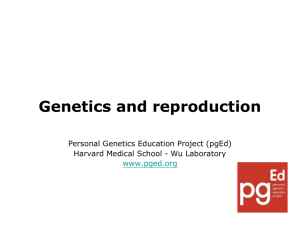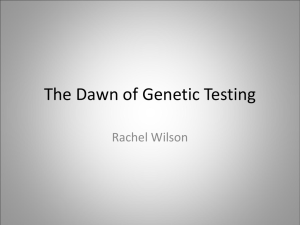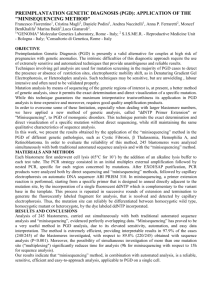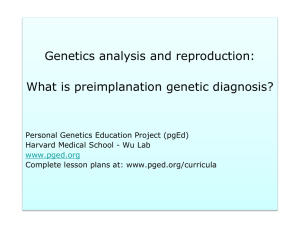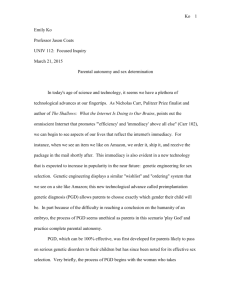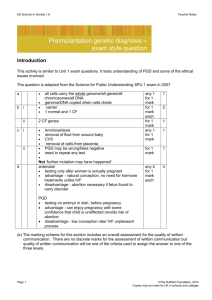Designer Babies
advertisement
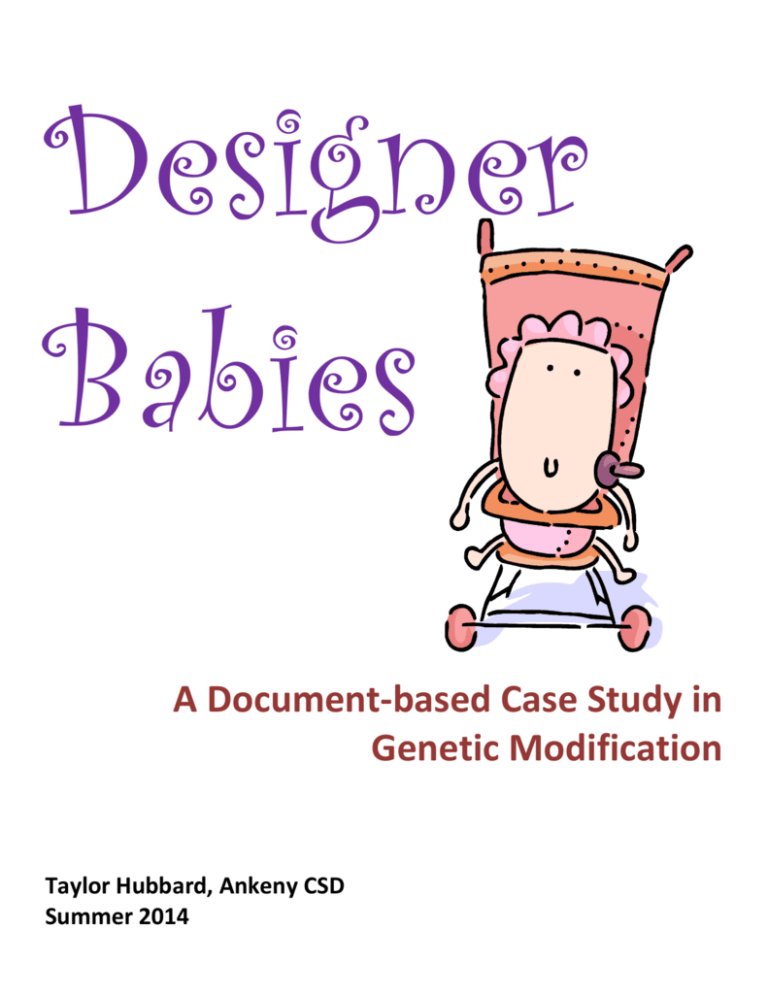
Designer Babies A Document-based Case Study in Genetic Modification Taylor Hubbard, Ankeny CSD Summer 2014 INTRODUCTION Have you ever wondered if it is possible to genetically engineer “Designer Babies”? Can parents today make choices for their pre-born children regarding certain traits? Actually, there is a medical procedure available that is a kind of “first-step” in this direction. It’s called Pre-implantation Genetic Diagnosis, or PGD. This activity is designed to engage your critical thinking skills. Based on what you learn, you will be asked to make a decision as to whether or not you would choose to use PGD to design your child. A SCENARIO “Kim tells me that you and Natalie are considering starting your family.” “Yes,” Drew replied. “But we have some concerns.” He and his work colleague Jeff were on their car pool commute to work. Drew and his wife Natalie had been friends with Jeff and Kim ever since both couples had moved to the city. “Like what?” asked Mike. “Well, it’s not a huge thing, but we feel a little pressure from my family to have a boy. My dad is an only boy, and I’m an only boy. Continuing the family name seems to be a big deal for some in my family,” said Drew. “Have you ever thought of using PGD?” asked Mike. “What do you mean? I’ve never hear of it,” answered Drew. Mike explained, “PGD stands for Pre-Implantation Genetic Diagnosis. It’s sort of a combination of in vitro fertilization and genetic screening, all in one. Kim and I are seriously considering it because we both have relatives with Down Syndrome, and we would like to improve our chances of having a child who doesn’t have that condition.” “How can you do that?” Drew was curious. “Well,” answered Mike, “it basically works like this: The doctor takes eggs and sperm from the prospective mother and father. An in vitro fertilization (IVF) is done, in which the eggs are fertilized outside the woman’s body, and several embryos are produced. One cell from each embryo can be removed and genetic testing done. Removing the one cell does not harm the embryo. The testing can be used for various purposes, like to determine the sex of the child or if a chromosomal mutation – like the one that causes Down Syndrome - is present. Testing can also show if the child will have certain genetic diseases – Cystic Fibrosis, for example - or even if there is an increased risk of diseases like breast cancer or early-onset Alzheimer’s Disease. The parents then have the choice of what embryos are implanted into the mother, and the ones you don’t want are discarded. “So we could find out which embryos were going to result in male babies, and have only those implanted into Natalie?” asked Drew. “I guess,” said Jeff. “PGD is used mostly to check for genetic diseases. But choosing the sex of your child is possible. In some countries it’s illegal to use PGD for that, but not in the United States.” QUESTION-PRODUCT Pretend you are Drew or Natalie and six months have passed since Drew and Jeff’s conversation in the car. In that time you have looked up quite a bit of information about Pre-Implantation Genetic Diagnosis, including some of the documents that follow. You came to a decision together several weeks ago. One day, as you are doing some research on the Web, you come upon an on-line discussion forum related to issues surrounding PGD. The person who has initiated the discussion has asked, “I am considering PGD before my pregnancy. My husband and I have learned we are both carriers for the gene that causes Cystic Fibrosis, and we don’t want to pass that on to our child. However, I am not sure if it is ethical or not? Should parents ‘design’ their child? Any thoughts?” Your task is to respond to her question with your own forum entry. It should be no longer than one page. Most importantly, it should state your decision about using PGD and explain the reasons behind your decision. Your reasoning should be based on your evaluation of the documents. Figure 1 B Image retrieved from the Journal of the American Medicine Association (jama.jamanetwork.org) on July 2, 2014. Figure 2 Image retrieved from www.emoryhealthcare.org Figure 3 Image retrieved from Mediterranean Journal of Hematology and Infectious Diseases (mjhid.org) on July 2, 2014. Diagram 1 Diagram 2 Image retrieved from biol1020-2012-1.blogspot.com on July 2, 2014 Image retrieved from www.lifeinvitr.com on July 2, 2014 Diagram 3 Image retrieved from biol1020-2012-1.blogspot.com on July 2, 2014 C D D Embryo Screening and the Ethics of Human Genetic Engineering By: Leslie A. Pray, Ph.D. © 2008 Nature Education Citation: Pray, L. (2008) Embryo screening and the ethics of human genetic engineering. Nature Education 1(1):207 In April 2008, Dartmouth College ethics professor Ronald M. Green's essay, "Building Baby from the Genes Up," was published in the Washington Post. Green presented his case in support of the genetic engineering of embryos, arguing that tinkering with genes could eliminate disease or confer desirable features onto our future progeny. "Why not improve our genome?" he asked. Two days later, Richard Hayes, executive director of the Center for Genetics and Society, rebutted, warning of a "neo-eugenic future" and "the danger of genetic misuse." These practically polar opposite opinions are two sides of a debate taking place around the world. The controversy revolves around what scientists are calling reprogenetics: the combined use of reproductive and genetic technologies to select, and someday even genetically modify, embryos before implantation—not for health reasons, but for the sake of "improvement." Introduced into clinical care in the early 1990s, PGD was first used for determining the sex of embryos to minimize the likelihood of transmitting fatalsex-linked disease genes to offspring. If there were a family history of Duchenne muscular dystrophy (DMD), for example, parents might choose to undergo embryo screening to identify female versus male embryos and then have only the female embryos implanted. (DMD is a recessive X-linked disease that affects mostly males.) Since the 1990s, clinical use of PGD has expanded from embryo sexing to single-gene diagnostic testing, such as for Huntington's disease. Today, reproductive clinicians regularly use PGD to diagnose some 170 different conditions, with two of the more common being cystic fibrosis and hemoglobin disorders (e.g., Cooley's anemia). A third and more controversial use of PGD involves screening for chromosomally abnormal embryos in an effort to improve the relatively low pregnancy rates and decrease the relatively high miscarriage rates associated with in vitro fertilization procedures (which are often due to chromosomal abnormalities). Most recently, and even more controversially, at least two British couples have relied on PGD to screen embryos for the presence of BRCA mutations associated with increased risks of breast cancer. Both couples came from families that had suffered several generations of breast cancer, and both couples wanted to eradicate breast cancer from their lineage once and for all. In Britain, all PGD procedures must be approved by a formal regulatory agency, the Human Fertilisation and Embryology Authority (HFEA), and these cases initially stumped the HFEA. After lengthy deliberation, the HFEA finally approved the couples' requests. Green argues, "[T]he critics' concerns may be less troublesome than they appear." He insists that parents will not love their children any less in the quest for perfection, and children will not feel pressured to live up to perfectionist expectations; if they do, the problem is with the parenting, not the genetic manipulation. Dr. Hayes vehemently disagrees, arguing that while the technology of PGD has the potential to eliminate many horrible diseases, it could also do some real harm: "If misapplied, [these technologies] would exacerbate existing inequalities and reinforce existing modes of discrimination. . .the development and commercial marketing of human genetic modification would likely spark a techno-eugenic rat-race. Even parents opposed to manipulating their children's genes would feel compelled to participate in this race, lest their offspring be left behind." Adapted from article retrieved from www.nature.com/scitable/topicpage/embryo-screening-and-the-ethics-of-human-60561 E D The First Genetically Modified Human Embryo: Advance or Abomination? BY BRANDON KEIM 5.12.08 8:58 AM Scientists have created the first genetically modified human embryo. What does this mean to you? Led by Nikica Zaninovic, researchers at Cornell University added a green fluorescent protein to an embryo left over from assisted reproduction. They destroyed the embryo five days later. It is believed to be the first documented genetic modification of a human embryo. The research raises a number of thorny ethical questions. Though adding a fluorescent protein was not aimed at enhancement, but rather to illuminate developing embryos, scientists say that modified embryos could be used to research human diseases. They say embryos wouldn’t be allowed to develop for more than a few weeks, much less implanted in a woman and brought to term. If the embryos were allowed to develop, genetic modifications — which would be permanent and passed to future generations — might prevent disease. Modifications might also be used for other reasons — physical appearance, intellectual prowess, personality — though the necessary science remains hypothetical at this point. Developing such techniques would necessarily entail trial-and-error and risk-taking with human life. So let’s have that debate. What do you think, Wired Science readers? Should genetically modified embryos be used in research, but not reproduction? Both? Neither? Adapted from http://www.wired.com/2008/05/the-first-genet/ myreality Pre-Implantation Genetic Diagnosis (PGD) F D I am about to begin IVF Cycle #2. Due to a previous high risk pregancy, my RE has recommended PGD so that we only put one embryo back and have a better chance of it being a healthy/normal ebmryo. Has anyone done this? Your thoughts?!? 3 ladybugs For this purpose I am not sure how it would help you. I understand that you are looking at things that might cause a miscarriage but there is no way to tell with PGD if you will have someone that would implant. I will also be doing a single embryo transfer next time and the thought of doing PGD hasn't honestly crossed my mind. Though that could be because I know it isn't an exact science. Good luck with whatever you do though! thebabybaker I'm doing PGS/CGH because I've had 4 transfers with 9 seemingly perfect grade 1 embryos and nothing to show for it. I'm hoping the embryo testing will uncover why we haven't gotten (and stayed) pregnant yet. My RE says a normal embryo has a 60% chance of pregnancy so that's a plus but not a guarantee. Good luck with your decision! myreality The main reason that my RE is recommending it is to increase the chances that the one that is put back is "normal". Due to my age, putting back more that one is not optimal. I was just curious about the decision making process, especially since knowing the sex is part of PGD. I feel weird about knowing that from the start...especially with the obvious chance that it may not take. thebabybaker I'm not planning to find out the gender. You can ask them to omit that bit of info from the report. naybird222 I'm doing PGD for the first time. My RE is recommending it because after 8 embies transferred, none have implanted. So she said the next step would be to test the embryos. We normally transfer 4, but this time we will do 2. PGD is expensive but I am hoping and praying it's worth it!!!!!!! myreality thebabybaker - When you say omit do you just mean that they don't have to give you that result? I don't know why I am weirded out by it. On one side I don't want to pick the gender at all but then the other side is someone else is making the decision so maybe we should?!? naybird222 - I believe the price we were quoted is $1800 for the first 6 embies and the $250 for each additional?!? Something like that. It is a lot of money out of pocket but I agree with you. Anything to increase the chances of implanting a normal embryo is a great option. thebabybaker myreality -. picking gender for me personally is taking science one step too far, plus there aren't many surprises in life and i want this to be one of them! Adapted from http://www.fertilethoughts.com/forums G D PGD and IVF Costs - What is the cost for preimplantation genetic diagnosis and/or PGS (preimplantation genetic screening)? There are several variables involved in the cost of PGD 1. 2. 3. 4. The cost of in vitro fertilization at the PGD clinic The cost of IVF medications Embryo biopsy procedure costs at the PGD clinic Chromosomal and/or genetic analysis costs - the PGD testing Average preimplantation genetic testing costs in the US 1. 2. 3. 4. 5. IVF costs - in the US the average cost for IVF with ICSI is about $12,000 to $13,000 The average cost for in vitro fertilization medications is $3000 to $4000 Embryo biopsy charges are about $1500 to $2200 Aneuploidy testing (for chromosome normality) with PGD is $2200 to $5000 For single gene defects (such as cystic fibrosis), the cost is about the same as for aneuploidy screening, $2200 to $5000 Average PGD IVF Costs Price at Our Clinic in USA IVF-ICSI cost $12,000 Related Pages PGD - PGS overview PGS for chromosome screening Trophectoderm biopsy and video PGS with day 3 embryo biopsy PGD for genetic diseases IVF cost details Age and fertility Age & chromosome problems IVF and age IVF in women after age 40 Age and miscarriage Our IVF success rates Our donor egg success rates Our available egg donors $12,000 IVF medication costs About $3500 About $3500 Embryo biopsy cost $1800 $1800 PGD test cost $3500 $2200 Total $17,200 + meds $14,600 + meds IVF with preimplantation genetic testing (with meds) usually costs $17,000 - $22,000 This is depends on the cost of the in vitro fertilization and also on the amount of medications needed for IVF ovarian stimulation Since in vitro fertilization pricing varies between IVF-PGD centers and because the dose of meds for IVF varies, the total cost for IVF and preimplantation genetic testing will vary The big variables with PGD costs for a self-pay patient (no IVF insurance coverage) are the cost of in vitro fertilization and IVF medication costs IVF medications IVF medication costs are determined by how the ovaries respond to the drugs. A young, thin woman with a good antral follicle count and good ovarian reserve would be on lower doses of stimulation medications (therefore, a lower cost) A heavier woman with a high BMI, or with advanced age or reduced ovarian reserve needs higher doses - so medications could be as much as $6000 Insurance coverage for IVF and PGD Some couples have insurance coverage for in vitro fertilization, but it is unlikely that insurance would cover chromosomal or genetic testing. Adapted from http://www.advancedfertility.com/pgd-costs.htm Designer Babies Intended Audience Time Required - Be careful to describe in minutes – stay away from the words, “periods or blocks”. Check all that apply… th ☐ 9 grade ☐ general audience th ☐ 10 grade ☐ advanced audience th ☐ 11 grade th ☐ 12 grade Approximately 120 - 150 minutes Taylor Hubbard Ankeny High School Ankeny, Iowa taylor.hubbard@ankenyschools.org Check all that apply… ☐ general science ☐ ☐ earth science ☐ ☐ physics/phys sci ☐ ☐ environmental science ☐ biology chemistry biotechnology ___________ Introduction/Background Where in the semester is this case best suited, and what type of background do the students have when they encounter the case? Designer Babies is about the ethics of Pre-Implantation Genetic Diagnosis (PGD), a reproductive technology that is readily available and in use today. The activity requires students to have a basic understanding of DNA, genes, chromosomes, meiosis, and basic heredity principles. An understanding of the concepts of fertilization, zygote, and embryo would also be helpful. Objectives of the Case List exactly what the students should know and be able to do after they have finished the case that they didn’t know and couldn’t do before they went through the case. Designer Babies is designed to help students develop two skills: 1) Students will evaluate documents critically. As they analyze the documents that accompany the activity, they will ask themselves questions such as - How reliable is the source of this information? Does the author have any biases that must be taken into consideration? Is the information presented relative to the issue at hand? 2) Students will make a claim stating a personal stance/decision and support this decision with at least two reasons based on information derived from the documents. Major Issues – Identify the major issues in the case that the students should analyze. Indicate which issues you think will (should) come up and what information you expect students to extract from each document. The question underlying the activity is this - For which purposes is Pre-Implementation Genetic Diagnosis (PGD) proper and ethical? Each document is intended to provide information students must evaluate and use (or not use) in making their own decision. Document A: This document introduces the topic, presents the scenario, and outlines the task students must complete. Document B: Students should notice from Figure 1 that people feel differently about the ethical use of PGD depending on the intended purpose of the procedure. Figure 2 has information not directly related to the issue; however, some students may take from it that IVF is not always effective, thus PGD may not be worth the expense. Figure 3 shows that PGD is effective for reducing births of children with β-thalassemia, although the reliability of the source may be questioned. Document C: The diagrams in this document enable students to visualize the PGD process. Some students may recognize that Figure 3 is presenting a hypothetical, in-the-future situation. While PGD can be used to determine and select for gender, traits like green eyes and blond hair cannot be selected for at this time. Document D: This article, though rather long and text-based, is important to help students understand the basics of the issue. Written by a scientist and published in a credible journal, the PGD process is described and arguments - both pro and con - are introduced. Because of its length, some teachers may decide to skip this document or substitute an alternative. Document E: The blog presented here is similar to Document D in that it introduces the topic and outlines the questions people have. However, it is much shorter and more reader-friendly. Students should recognize that even though it covers much of the same ground as Document D, it is not from a “scientific” source and sensationalizes the topic more. Document F: In analyzing this online discussion forum, students should recognize that some characters are concerned with the ethics of PGD when used to determine gender. The fact that IVF is not always effective is presented again in this document, and the prohibitive cost of PGD is mentioned for the first time. Document G: The costs associated with IVF and PGD are presented. Students may ask whether or not Drew and Natalie have insurance that will cover the procedure. The teacher may want to make a call here, or let students decide. Assuming the couple does have insurance may force students to base their stances on ethical arguments rather than financial ones. Classroom Management Tells the reader just how the case should be used in a classroom situation. The explanation must be presented in detail. What to do first, second, and last? How long do certain activities take? Indicate any pre-class assignments and follow-up assignments that might be used after a discussion of the case is finished. Include study questions and questions you will be asking in the classroom throughout the case. Include what you write on the board to direct and guide students throughout the case. Provide closure for students – how do you wrap up this activity up? Designer Babies could be conducted with students in a variety of ways, according to teacher preference. Here is one possible way of going about it: Have the students read through Document A to introduce the activity. The teacher may want to do the Introduction as a “Read Aloud”. Discuss as a class the Scenario and Question/Product. Before moving on, write the following questions on the board: How reliable is the source of this information? Does the author have any biases that must be taken into consideration? Is the information presented relative to the issue at hand? How does the information in this document influence my thinking about using PGD to choose the gender of a baby? These questions can remain on the board for the rest of the activity. (30 minutes) Students analyze Documents B and C. It may be easier to start with Document C, which diagrams the PGD process. The teacher may want to discuss the diagrams with the class and assess how well the students understand this process and clear up any misconceptions. Relate the diagrams in Document C to Jeff’s explanation of the procedure described in Document A. As they analyze the documents, students should consider the questions on the board and jot down notes about their thinking. (30 minutes) Students read Document D. Before reading, the teacher should address any vocabulary with which the students may have difficulty. Also, before reading, remind the students of the questions on the board and the overall assignment they have been given. The teacher may want the class to read the article in “chunks”. After each “chunk”, give the students the opportunity to talk with a partner or in a small group about what they have read. Whole class discussion may follow to allow for any questions. (30 minutes) Students read Documents E, F, and G. Again, prepare the students with difficult vocabulary, restate the purpose of the activity, and remind them of the questions on the board. Allow students to talk together in pairs or small groups after each document and allow time for students to jot down notes regarding the questions and their thinking. Tie the work together with a class discussion to answer questions. (30 minutes) Students can complete their assignment, the discussion forum entry, outside of class. Or, if time allows, the teacher could give students a set amount of time to write in class. The teacher may also want to take some time, either before or after reading the students’ responses, to have students share their opinions and reasoning in a whole class setting. (30 minutes) References & Resources Include a list of references to follow up particular lines of thought or included in your documents. May also include online resources & associated URLs. “Building Baby From the Genes Up”, Ronald Green, Washington Post, 2008. (http://www.washingtonpost.com/wp-dyn/content/article/2008/04/11/AR2008041103330.html) Assessment of product – Identify the product that students will produce as a result of this DBCS. Do you evaluate class discussions? Do you have students complete peer evaluations? What are students expected to complete? Do you have a rubric to evaluate the final product? Include as many tools for this element as possible. Each student is expected to turn in a typed or handwritten document that represents his/her online discussion forum post. It should be at least one-half page long, although length is not as important as content. Each post should include: “Genetically Modified Humans? No, Thanks!”, Richard Hayes, Washington Post, 2008. (http://www.washingtonpost.com/wp-dyn/content/article/2008/04/15/AR2008041501620.html) Document D references and summarizes these two articles. They may prove useful for the teacher as a source of background information, or they could be used as extension / differentiation activities for advanced students. A statement communicating the student’s stance on the issue raised by the prospective mother as outlined in the Questions/Product section of Document A. (“I am considering PGD before my pregnancy. My husband and I have learned we are both carriers for the gene that causes Cystic Fibrosis, and we don’t want to pass that on to our child. However, I am not sure if it is ethical or not? Should parents ‘design’ their child? Any thoughts?”) At least two reasons explaining why they think the way they do. Each reason should include a statement of the reason itself as well as several sentences that explain the reason. These explanations should refer to and be based upon specific information found in the documents. In our science department, we often assess formatively with the following simple rubric: Exemplary (E) – The student has made a clear statement of position. The position is supported with two or more reasons. Each reason is exceptionally well-explained using elaborated points from the documents. Stable (S) – The student has made a clear statement of position. The position is supported with at least two reasons. The reasons are explained using points from the documents. Developing (D) – The student position statement is unclear, OR less than two reasons are provided, OR at least two reasons are provided, but are not explained OR reasons are not explained using information from the documents. In other words, the student has failed to meet one of the assessment criteria. Beginning (B) – The students has failed to meet two or more of the assessment criteria. After reading the student products, the teacher can identify 1-2 that fall into each category. These can be presented to the class using a document projector, and the teacher can comment on how each one met (or did not meet) the assessment criteria. At any point in the activity, if the teacher determines that students are struggling to draw meaningful information from the documents, or in evaluating the documents in the way they were intended, a Document Analysis Prompt could be used. The Document Analysis Prompt is a series of questions the students can answer and record responses to as they read each document. The Prompt provides a scaffolding tool that may help students track their thinking as they progress through the activity. A copy of a possible Document Analysis Prompt is provided on the next page. Document ____ Description of Document: When was it written? By whom was it written? For whom was it written? How is it relevant to the topic? Is the information in it reliable? Yes/No? Why? What in this document supports using PGD to screen embryos for cystic fibrosis? What in this document supports NOT using PGD to screen embryos for cystic fibrosis? Document ____ Description of Document: When was it written? By whom was it written? For whom was it written? How is it relevant to the topic? Is the information in it reliable? Yes/No? Why? What in this document supports using PGD to screen embryos for cystic fibrosis? What in this document supports NOT using PGD to screen embryos for cystic fibrosis?

